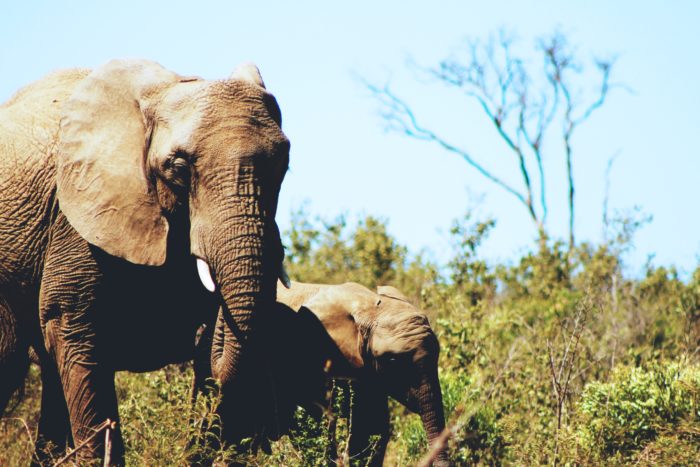
Did you know that it is predicted that up to 21% of South East Asian rainforest species will be gone by 2021?
Did you know that analysis of data studying African forests elephants over a nine-year period between 2002-2011 revealed a population decline by sixty-five percent?
These statistics are unsettling and alarming, so it’s critical, now more than ever, to really take the time to reflect on why species are vanishing at an unprecedented rate, and how we can make the necessary changes to try to save them.
- A version of this article appeared on A Peaceful Living.
As I mentioned in my Earth Day post, I’d like to think that we can collectively be more mindful of the way we live every day, and this notion extends to helping endangered and threatened species. Everything is connected. The things I buy and the way I choose to live up here in Rhode Island, USA can send a ripple effect of consequences across the world.
One of the largest extinction drivers is habitat loss caused by humans. Habitat loss could be caused by urban development, clearing land for agricultural development (soy for livestock or space to graze livestock, for example), or forest cleared to harvest a resource like palm oil or minerals.
In parts of Indonesia, massive swaths of bio-rich forests are being cleared and slashed and burned, at an alarming rate, to supply demand to the palm oil industry. Among the many organisms who call this disappearing ecosystem home, perhaps the most notable is the incredibly intelligent, and endangered orangutan. Palm oil is effectively destroying their homes, so with no place to go or food to forage, these animals are dying of starvation. Luckily the rescue organization International Animal Rescue in West Kalimantan, an area of Borneo, works tirelessly to save as many as they can. That their homes are putting orangutans in closer proximity to humans also leads to baby orangutans being stolen for the pet trade. To read more about palm oil and living palm-oil free visit Selva Beat.
Habitat loss can also lead to pocketing, in which a habitat becomes so fragmented that a particular species essentially becomes trapped and has nowhere to go or find food. Again, this leads to more frequent encounters with humans as animals who have no other place to go can wander into a populated area, trample or consume crops, and find themselves in conflict with humans. Stories of this occurring to elephants in Africa or Tigers in the Sundarbans are common and unfortunate.
Other major extinction drivers include global warming, invasive species, and overexploitation (i.e. hunting and poaching).
So, what can we do as individuals?
Here’s a list of 6 ways you can do you part every day to help protect endangered and threatened species:
1. Never purchase products made from endangered or threatened species.If there is a market for it, there will be a supply – even if the supply is sourced and traded illegally. The illegal wildlife trade thrives because there is a market to support it. Simply put, if you buy it, you’re supporting an industry that is a major contributing factor to the decline of various endangered species. Shark finning,poaching of elephants for their ivory, or the killing of beautiful manta rays for their gills are industries all driven by demand. You may think that purchasing an ornately carved elephant tusk or trying out the local delicacy that happens to include ingredients sourced from an endangered species while on vacation is no cause for concern because the damage has already been done–but you are directly feeding demand. Make sure you know what you’re buying before you buy it, and if there is any question as to how or where the product was sourced, just don’t buy it.
2. Never patronize tourist attractions or carnivals and circuses that use wild animals. There are many scenarios in which one might find themselves presented with the opportunity to interact with a wild animal or see one perform – a traveling circus is perhaps the most common example. Also worth considering is a subset of the booming tourism industry in which attractions featuring wild animals have become increasingly popular. For example, one might see the myriad elephant trekking companies operating throughout South East Asia and think it would be a fun and unique way to explore the natural surroundings and connect with incredible creatures. I understand the initial draw, but not only is it harmful to that particular elephant, it is harmful to the entire species. While some animals are bred in captivity to be used in entertainment and tourism industries, the majority are taken from the wild; overexploitation is a contributing factor to their decline. Tigers, monkeys, elephants, and certain species of bears are especially at risk as they are among the most popularly used animals for entertainment purposes. Using wild animals as entertainment is fraught with enough problems to warrant its own discussion, but worth noting here is the educational component it imparts to younger generations. When young people see wild animals like elephants, tigers, or monkeys only in the context of entertainment it serves to decrease the animals’ intrinsic value as a species existing in the wild – rather than associating them as autonomous beings who are valuable to the ecosystem as a whole, and in their own right, young people will associate them as mere fodder for entertainment. It’s important to provide true educational opportunities that will foster and encourage respect for wild animals and the need for their preservation and responsible stewardship. The fate of endangered species rests, in part, in future generations desire to save them.
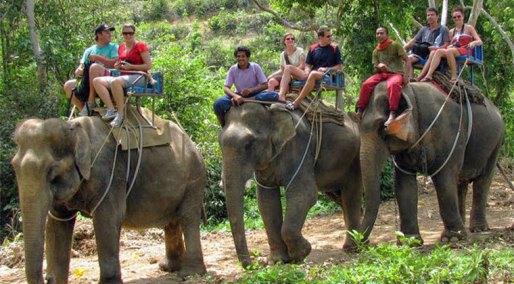
Never do this.
3. Don’t buy products that destroy threatened and endangered species habitat. The most glaring example of this is palm oil, which is a major contributing factor to the destruction of precious rainforest that is home to the orangutan, among other plants and animals. Choosing not to buy products containing palm oil and asking brands to use alternatives sends a clear message. As a consumer, you can have an impact by voting where you spend your money.
You can also make more conscious choices when buying products for your home. When shopping for furniture, for example, don’t buy tropical hardwoods or look for furniture made from recycled materials or from woods certified through the Forests Stewardship Council.
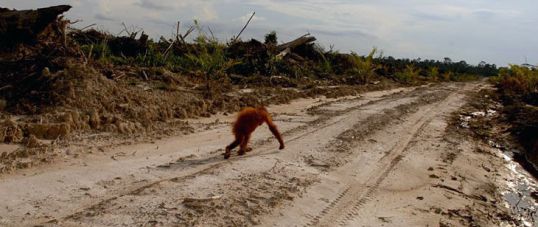
4. Recycle and dispose of trash responsibly (don’t litter–I’m looking at you careless beach goers!). Trash disposed of improperly can pollute wildlife habitats and even end up being accidentally ingested by unsuspecting animals. Another consequence of garbage is that it attracts animals, which can lead to human-animal conflict, but there’s another unintended consequence that you may be surprised to hear. Take the Roseate Tern, which is listed as an endangered species where I live in Rhode Island. There are several factors contributing to their decline, and one factor is predation due to predators finding their nests after being attracted to garbage left behind by beach goers. This further highlights the fact that all of our actions can have significant consequences.
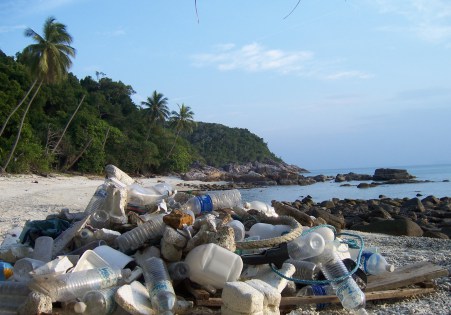
5. Visit and support your local state parks, wildlife refuges, sanctuaries, and open spaces. If the community is active in supporting and visiting local open spaces, the more likely it will be seen as valuable and an asset leading to more funding or conservation opportunities.
Apart from being beautiful spaces to connect with nature and see local wildlife, and provide educational opportunities to young people, these places provide space for wildlife to nest, breed, and eat. They also might be important stopovers for migratory animals. For example, I am lucky enough to have the Sachuest Wildlife Refuge very close to where I live. My husband and I enjoy taking morning walks along their trails on summer mornings where we can see native flora and fauna set against beautiful cobblestone beaches. These cobble beaches provide nesting areas for the migrating birds of RI, in addition to providing critical breeding habitat for the endangered Piping Plover.
Often when we think of endangered species we might, by default, think of the charismatic megafauna like tigers and elephants who we know to be endangered.
But, threatened and endangered species come in all shapes and sizes and range anywhere from a small humble beetle, to a tropical tree, or to a tiny amphibian. Every living thing has a role in the Earth’s ecosystem and any loss due to the actions of mankind is tragic. I encourage you to become familiar with the endangered species local to your area. Knowing this will help you make better choices and be more impactful in making a difference.
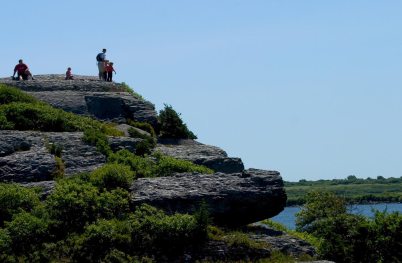
Where I live, in Rhode Island, there are several threatened and endangered species including the Piping Plover, Roseate Tern, the New England Cottontail Rabbit, and the Small-Whorled Pogonia (a rare orchid). The endangered orchid is threatened due to invasive species, logging, urban development, and the fact that, like many other orchids, it is collected for personal use. Historically, the New England cottontail was found throughout New England, but their numbers have been decreasing due to urban development and competition with the introduced eastern cottontail. The N.E. cottontail is no longer found in Vermont.
6. Remove animal products from your diet. Go Vegan! What we eat is a sensitive topic. I’ve learned this very well since having gone vegan a few years ago. People tend to take it very personally or get defensive when they believe they’ve been made to feel “badly” about the food they like to eat. This usually only presents itself as a problem or becomes uncomfortable when someone who isn’t genuinely interested in hearing my personal reasons for being vegan asks me why I no longer eat meat, eggs, or dairy. I’ve learned the hard way that those types of conversations are intended to back me into a corner or make some sort of joke about plants having feelings or about bacon. Those conversations are not effective and don’t lead anywhere positive. But when someone asks me because they sincerely want to know, then there is an opportunity to be open and empathetic in your explanation and educate them about topics they may never have connected with what’s on their plate.

Whatever one’s personal views about the moral or ethical implications of eating animals may be, one simply cannot deny the scientific, evidence-based case for adopting a plant-based diet for the health of the planet. Going plant based is the single most impactful action you can take to reduce your carbon footprint every single day.
Although the notion that adopting a plant-based diet to mitigate global warming and other environmental and social issues (i.e. worldwide hunger) has been gaining traction and coverage in some media outlets, most mainstream reporting focuses on the transportation sector when discussing carbon emissions. Many reports indicate that the livestock industry is responsible for more gas emissions than the transportation sector. From the report, Livestock’s Long Shadow: Environmental Issues and Options,”
The livestock sector is a major player, responsible for 18 percent of greenhouse gasemissions measured in CO2 equivalent. This is a higher share than transport. The livestock sector accounts for 9 percent of anthropogenic CO2 emissions. The largest share of this derives from land-use changes – especially deforestation – caused by expansion of pastures and arable land for feedcrops. Livestock are responsible for much larger shares of some gases with far higher potential to warm the atmosphere.
Eating plant-based foods reduces your personal carbon footprint because you are not supporting the animal agriculture industry. As with some of the other measures you can take, this is another example of where voting with your dollar comes into play. Reducing demand for meat, dairy, and other animal products will reduce carbon emissions and the use of other important resources like water, which has a direct impact on the health of the planet. Do your best to purchase locally sourced food whenever possible, as the packing and transport of food also contributes to one’s carbon footprint.
Did we miss anything? Are there any other ways to help protect endangered and threatened species?
Also by Stephanie: 5 Ideas for a Greener Wedding
What You Should Know about Coconut Oil and Animal Exploitation
Related: 7 Vegan and Palm-Free Beauty Brands
10 Fashion Companies Giving Back to Animals
Get more like this–sign up for our newsletter for exclusive inspirational content!
Photo: Cristy Zinn via Unsplash, Norman Bird Sanctuary




